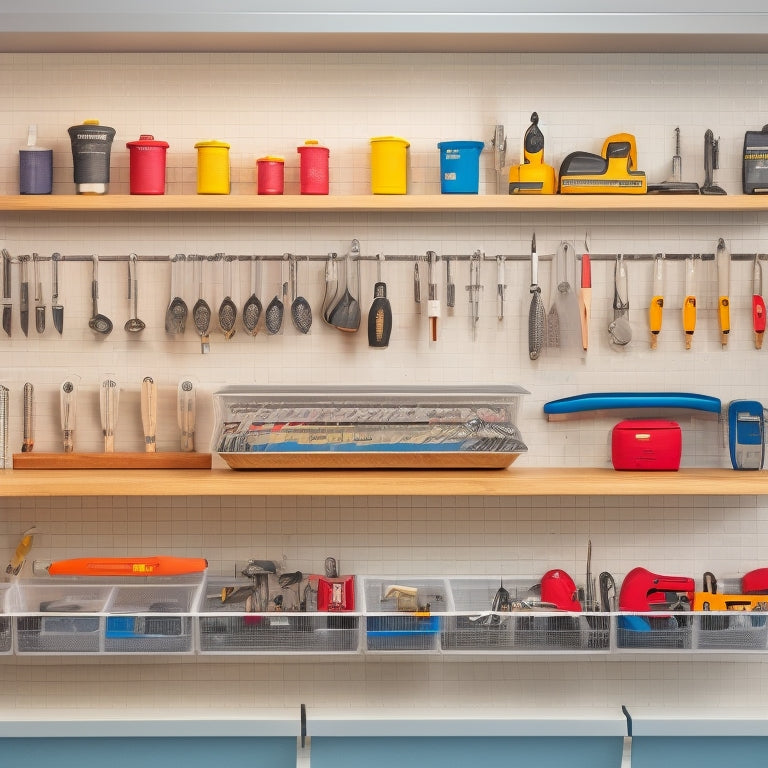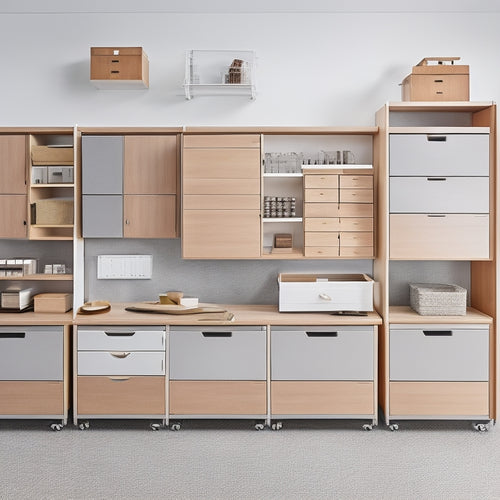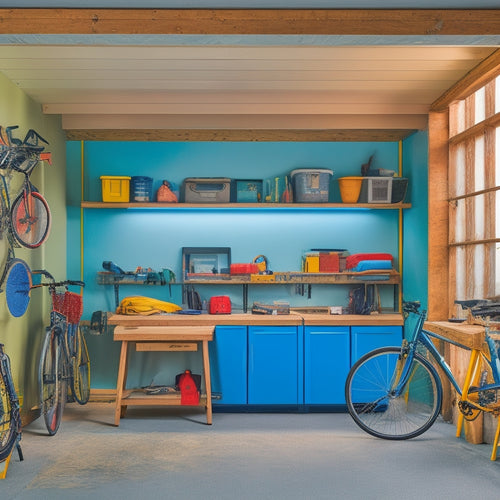
Tool Shelf Organization Made Easy in 3 Steps
Share
You're just three simple steps away from a clutter-free tool shelf! Start by purging and categorizing your tools, sorting them into hand tools, power tools, and accessories, and discarding broken or rusted items. Next, assign a home for each item, designating storage based on frequency of use and utilizing bins, baskets, and hooks for organized storage solutions. Finally, maintain your organized space by implementing regular cleaning and lubrication, scheduling weekly tidy-up sessions, and investing in space-saving solutions - and you'll be on your way to a workspace that's both efficient and stress-free, with more tips and tricks to come!
Key Takeaways
- Remove all tools from shelves, sort into categories, and discard broken or rusted items to declutter and purge the tool shelf.
- Assign a home for each tool based on frequency of use, utilizing bins, baskets, and hooks for organized storage solutions.
- Implement regular cleaning and lubrication of tools, schedule weekly tidy-up sessions, and develop habits to prevent clutter from accumulating again.
- Designate storage for less frequently used items in higher or lower shelf locations, keeping tools and supplies off the floor.
- Clearly label each storage solution for easy identification and ensure tools are returned to their designated spots after use.
Purge and Categorize Your Tools
Since you've decided to tackle tool shelf organization, begin by taking everything off the shelves and sorting items into categories. This step is essential in identifying what you have, what you need, and what you can discard.
Separate tools into categories like hand tools, power tools, and accessories. Within these categories, further sort items by tool types, such as hammers, screwdrivers, and pliers.
As you sort, inspect each tool for damage or wear. Discard any broken or rusted tools to prevent accidents and guarantee your safety. Consider donating gently used tools or repurposing them as storage solutions.
Set aside tools that require maintenance or repair for later attention.
With your tools sorted and purged, you'll have a better understanding of your storage needs. You can now start thinking about the most effective storage solutions for your remaining tools.
This will help you maximize your shelf space and create a more efficient workflow. By categorizing and purging your tools, you'll be well on your way to a more organized and safe workspace.
Assign a Home for Each Item
Now that you've purged and categorized your tools, it's time to assign a home for each item. This step is essential in maintaining a safe and organized workspace. When each tool has a designated spot, you'll reduce the risk of accidents and increase productivity.
To assign a home, consider the frequency of use, size, and type of tool. Store frequently used items in easy-to-reach locations, while less frequently used items can be stored higher or lower on the shelf. Use tool storage solutions like bins, baskets, and hooks to keep items organized and off the floor.
Here's an example of how you can organize your tools:
| Tool Type | Storage Solution | Label |
|---|---|---|
| Hand Tools | Small Bin | Hand Tools |
| Power Tools | Large Bin | Power Tools |
| Fasteners | Small Basket | Fasteners |
Label each storage solution clearly, so you can easily identify where each tool belongs. This will help you maintain order and guarantee that tools are returned to their designated spot after use.
Maintain Your Organized Space
Your tool shelf organization system is up and running, but the real challenge lies in maintaining this new sense of order. It's easy to let clutter build up again, but with a few simple habits, you can keep your tool shelf organized and functional.
Start by implementing tool maintenance tips, such as regularly cleaning and lubricating your tools. This won't only keep them in good condition but also prevent rust and corrosion from building up.
Next, designate a specific time each week to tidy up your tool shelf, putting away tools and supplies that are out of place.
To guarantee you're making the most of your space, consider investing in space saving solutions like stackable bins or hanging organizers. These will help keep your tools and supplies off the floor and out of the way, freeing up significant space for other essentials.
Frequently Asked Questions
How Do I Handle Tools That Don't Fit on the Shelf?
When you're faced with tools that don't fit on the shelf, you'll need overflow solutions. Consider alternative tool storage options like bins, baskets, or hooks to keep them organized and within reach, ensuring a safe and clutter-free workspace.
Can I Use a Pegboard for Tool Storage?
"Cut to the chase" and consider a pegboard for tool storage - it's a transformative solution! You'll love the benefits like easy access and visibility, plus installation tips include using a level and anchors for a secure hold, ensuring your safety while working.
Are Stackable Bins Suitable for Heavy Tool Storage?
You're considering stackable bins for heavy tool storage, but you're right to wonder if they're up to the task. While they're great for light to medium-weight items, heavy tools might be too much for them, compromising their stability and your safety.
How Often Should I Audit My Tool Collection?
You're drowning in a sea of wrenches and screwdrivers, with tools scattered everywhere! To avoid this chaos, you should audit your tool inventory every 3-6 months to guarantee storage frequency matches your usage, keeping your workspace safe and efficient.
Can I Customize My Tool Shelf to Fit My Needs?
You can definitely customize your tool shelf to fit your needs! Design a personalized storage system that suits your workflow by incorporating adjustable dividers, bins, and hooks to create a customized tool shelf design that enhances safety and efficiency.
Conclusion
"Congratulations, you've tamed the tool chaos! Your newly organized space is a haven of productivity, where every item has a designated 'sweet spot.' Maintaining this harmony is key. Set aside time each week to guarantee everything remains in its assigned home. This habit will become second nature, and you'll reap the benefits of a clutter-free zone where creativity and efficiency thrive."
Related Posts
-

Modular Tool Storage Systems for Small Spaces
You can optimize your small workspace by leveraging modular tool storage systems that intelligently employ vertical s...
-

7 Essential Foldable Workbenches for Garages
When selecting a foldable workbench for your garage, you'll want to contemplate factors such as space-saving design, ...
-

What Are the Advantages of a Wooden Tool Box
You choose a wooden tool box, you're not only getting a reliable storage solution, but also a long list of benefits t...


